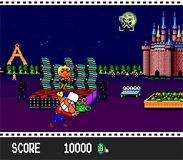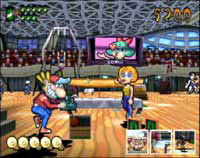Quick look: Gekisha Boy series
On my trip to Japan last March, I had the chance to pick up both The Cameraman for PS1 and Gekisha Boy 2 for PS2 for cheap. I’ve been able to play through both in the past few days, so now’s as good a time as any to talk about them a bit.
 Gekisha Boy was originally a PC Engine game released in 1992, which was relatively late for a HuCard release. It’s not quite like anything that had come before: your character can move back and forth on the auto-scrolling playfield, but as you control the photographer, a box that represents your camera’s viewfinder also moves. You use that to target subjects and photograph them for points. Particularly interesting subjects, often involving references to ’80s movies and pop culture, are strewn throughout the levels, and capturing them can net you extra film and power-ups. Timing is always important. You’ll get more points and that 5-shot film pack if you capture that Marilyn Monroe look-alike just as the air vent is blowing up her dress, but not before or after. And the goal of a level isn’t simply to get to the end: it’s to finish with a certain point total, so you’d better make sure to get as many juicy shots as you can. With as original as the premise still is, the game stood out that much more on a platform that was cluttered with mediocre shooters and platformers, and it became a cult classic in its home territory.
Gekisha Boy was originally a PC Engine game released in 1992, which was relatively late for a HuCard release. It’s not quite like anything that had come before: your character can move back and forth on the auto-scrolling playfield, but as you control the photographer, a box that represents your camera’s viewfinder also moves. You use that to target subjects and photograph them for points. Particularly interesting subjects, often involving references to ’80s movies and pop culture, are strewn throughout the levels, and capturing them can net you extra film and power-ups. Timing is always important. You’ll get more points and that 5-shot film pack if you capture that Marilyn Monroe look-alike just as the air vent is blowing up her dress, but not before or after. And the goal of a level isn’t simply to get to the end: it’s to finish with a certain point total, so you’d better make sure to get as many juicy shots as you can. With as original as the premise still is, the game stood out that much more on a platform that was cluttered with mediocre shooters and platformers, and it became a cult classic in its home territory.
 Almost inexplicably, a sequel was released in 2001 on the PlayStation 2. Gekisha Boy 2 resembles the original’s cartoony style, but instead of a completely flat 2D look, it uses PaRappa-like cut-out sprites and fully-3D stages to make framing trickier and to add even more secrets to the mix. Set in Japan this time, it’s very faithful the original, and retains the 2D play style, wicked and voyeuristic sense of humor, and movie references in spades. Some new gameplay elements genuinely add to the mix, like a zoom function to let you get better framing on a subject far in the background, a flash to aid in clearing the screen of stray projectiles and illuminating hidden subjects, and a dash to help avoid said projectiles. Extra film comes more quickly and easily than in the original, and levels have a faster pace in general, with many more targets to snap and more secrets to locate. The level count in this is higher than in Gekisha Boy, but a good portion of the stages are hidden, and can be unlocked by scoring certain shots on the regular run of levels. With as unflattering as most retro revivals have tended to be, a solid sequel like this is a pleasant surprise.
Almost inexplicably, a sequel was released in 2001 on the PlayStation 2. Gekisha Boy 2 resembles the original’s cartoony style, but instead of a completely flat 2D look, it uses PaRappa-like cut-out sprites and fully-3D stages to make framing trickier and to add even more secrets to the mix. Set in Japan this time, it’s very faithful the original, and retains the 2D play style, wicked and voyeuristic sense of humor, and movie references in spades. Some new gameplay elements genuinely add to the mix, like a zoom function to let you get better framing on a subject far in the background, a flash to aid in clearing the screen of stray projectiles and illuminating hidden subjects, and a dash to help avoid said projectiles. Extra film comes more quickly and easily than in the original, and levels have a faster pace in general, with many more targets to snap and more secrets to locate. The level count in this is higher than in Gekisha Boy, but a good portion of the stages are hidden, and can be unlocked by scoring certain shots on the regular run of levels. With as unflattering as most retro revivals have tended to be, a solid sequel like this is a pleasant surprise.
 Gekisha Boy was rereleased for the Playstation in 2002 as The Cameraman, as part of D3 Publisher’s Simple 1500 Series. The port is as close as one could hope for, and there’s a new stage that becomes available after you’ve finished all of the original stages. The new stage is somewhat easier than the originals, but the multitude of subjects, as well as the additional ammunition available, make for a speedier pace and a more dense experience that feels a lot like the sequel.
Gekisha Boy was rereleased for the Playstation in 2002 as The Cameraman, as part of D3 Publisher’s Simple 1500 Series. The port is as close as one could hope for, and there’s a new stage that becomes available after you’ve finished all of the original stages. The new stage is somewhat easier than the originals, but the multitude of subjects, as well as the additional ammunition available, make for a speedier pace and a more dense experience that feels a lot like the sequel.
Irem has taken credit for this series throughout its lifetime, but the real culprits are Tomcat System, who have ended up outlasting Irem’s original incorporation, and who now develop primarily for D3. Tomcat System is a tiny little developer and is composed of mostly the same folks it’s had on hand since the beginning, so it’s no surprise – but still refreshing – that they’ve been able to maintain the essense of the series across several console generations.
Folks to whom I introduce these games always recall Pokemon Snap immediately, but the solid play mechanics, attention to detail, and sense of humor in these two make them much more worthy of one’s attention than other attempts at turning photography into an action game. And while the PC Engine original fetches some healthy prices these days, the sequel and the Playstation port both go for relatively cheaply. It’s worth the effort to track them down.